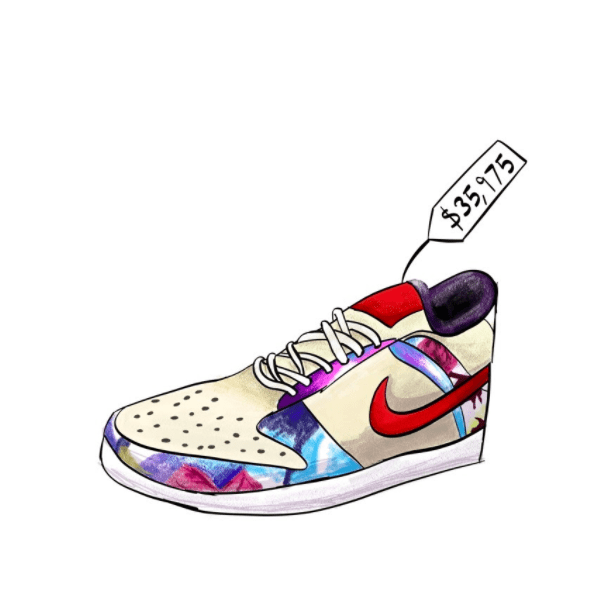What is the “hype” around sneakers?
May 2, 2021
$35,975. That is the average sale price of Nike SB Dunk Low Paris sneakers on StockX. For comparison, one could buy a brand new 2021 Mercedes-Benz A-class with that exorbitant price tag. For many, it is impossible to fathom what could drive an individual to pay that much money for mere sneakers. But this is not an uncommon phenomenon. Hundreds of limited-release sneakers resell on the secondary market for prices multiple times greater than their original retail prices. So the question is, what sparks this “hype” around specific sneakers?
The question is both simple and complicated. Even as a self-proclaimed sneakerhead who has resold and purchased sneakers at excessive prices, the full reasoning eludes me. The simple answer: supply and demand. The lower the supply and the higher the demand for a shoe, the higher the second-hand prices will be. This is a basic concept of economics and how markets function, but let us see this in action. Those SB Dunk Low Paris sneakers mentioned earlier? Only around 200 pairs were ever made, but they were HIGHLY desirable. They were set to release at an exhibit in Paris as a collaboration between Nike and French Painter Bernard Buffet. On top of this, it was a model as historically popular and famous as the Nike Dunk; first released in 1985 alongside the Air Jordan 1 (which we will talk about later), the shoe has many admirers, especially within the skateboarding community. The result of a sneaker that hundreds of thousands want but only approximately 200 can have: a sneaker at the same price as a luxury car.
But the more important question is, why do some factors increase the allure of sneakers to such an extent? This answer lies in the history of sneaker culture. The growth of sneaker culture started in the 1980s with iconic figures such as Michael Jordan dominating the basketball world and the rise of Hip-Hop. Jordan along with Nike released their famous Air Jordan collection which became an instant hit; all across the nation, everyone wanted to “be like Mike” and wear the latest shoes he was wearing on the court. Basketball shoes evolved from items purely made for athletics into a mainstream, fashionable accessory. In addition, famous Hip-Hop artists further diffused the influence of sneakers. Artists wore the latest, coolest kicks as a part of their aesthetic. Sneakers were also mentioned in music, and as a result, younger generations embraced sneaker culture as a means of self-expression and staying on-trend. This is the foundation for today’s sneaker world. Sneaker models that hold historical significance, collaborate with important names in pop culture, and also look visually appealing generate extraordinary hype in the sneaker community; even two out of three of these can create significant demand! On top of this, this recognizability and hype further spread sneaker fanaticism to the masses: Hypebeasts, Hip-Hop and Pop fans, and those looking to be trendy. As junior Will Sun simply put it, “people like shoes because they can use them to express themselves and look nice.” These aspects above are what drive crazy demand, and it is evident with many popular shoes today. Hip-Hop artist Travis Scott and Jordans’ collaborations easily fetch price tags of over $1,000, and the Off White Jordan 1 collaboration in Michael Jordan’s original Chicago colorway fetch prices over $5000.
All in all, sneakers are no longer just an accessory for walking. Nowadays, for many people, following sneakers is a hobby and a culture. Sneakers have established themselves in pop culture through collaborations with famous celebrities, basketball stars, and hip-hop artists. They also present important means of self-expression for the younger generation. Their history and exclusivity only serve to add fuel to the fire. With the rise in popularity of athleisure and streetwear, even in the world of high fashion, sneakers are here to stay.








